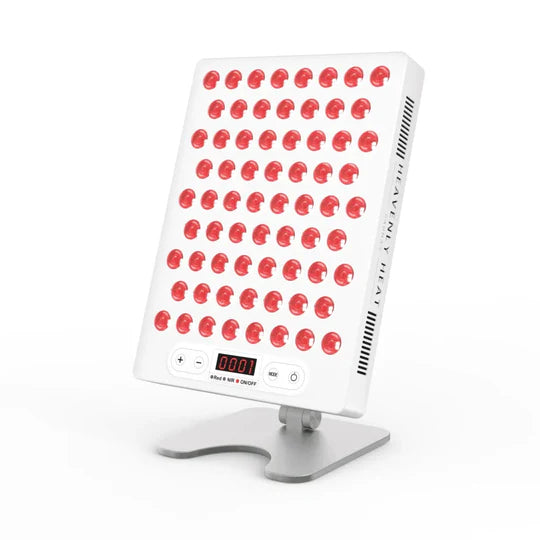Can You Do Red Light Therapy After Botox?

Red light therapy is a popular treatment for promoting skin health and healing. However, if you’ve recently had Botox, you may wonder if it’s safe to combine the two.
One of the most common questions is: Can you do red light therapy after Botox? In this blog post, we’ll dive into this question and more to help you make an informed choice.
Key Takeaways
- It's best to wait 24-48 hours after Botox before doing red light therapy to ensure the Botox settles properly.
- Red light therapy can speed up Botox recovery by reducing swelling and boosting collagen production.
- Combining red light therapy with Botox can improve skin texture and tone, complementing the effects of Botox.
- Red light therapy can reduce Botox-induced redness and inflammation, promoting faster healing.
Understanding Botox and its Effects
Botox, a neurotoxin derived from Clostridium botulinum, has been used for years to treat wrinkles caused by muscle movement, as explained by Dr. Michele Green, a New York City-based cosmetic dermatologist.
It works by temporarily "freezing" targeted muscles, providing a smoother, line-free complexion.
Botox is not only used for cosmetic purposes but also for medical conditions, such as treating hyperhidrosis (excessive sweating), migraines, neck spasms, and lazy eyes, as noted by Dr. Sarmela Sunder, a Beverly Hills facial plastic surgeon.
Additionally, Botox can reduce the size of the masseter muscle, creating a slimmer jawline.
Botox doesn’t permanently alter the skin or muscles; if you stop using it, wrinkles return to their pre-treatment state, as explained by Dr. Alina Bridges, Director of Dermatopathology at the Zucker School of Medicine.
Can You Do Red Light Therapy After Botox?
You should avoid red light therapy immediately after Botox because it may interfere with the Botox settling into your muscles.
Experts recommend waiting at least 24-48 hours to ensure the Botox takes full effect.
While red light therapy is generally safe, it's best to consult your provider for personalized advice.
Avoid other activities like exercising, lying down, or rubbing the treated area for the first day.
The Benefits of Combining Red light with Botox
It helps with Botox recovery
Combining red light therapy with Botox speeds up recovery by reducing swelling and promoting collagen production.
Start red light therapy 24–48 hours after Botox for the best results. Alongside red light therapy, stay hydrated, avoid touching your face, and skip strenuous activities to maximize your recovery.
Improved Collagen Production
Red light therapy, known for stimulating collagen deep within the skin, pairs well with Botox by supporting its anti-aging benefits.
A 2014 study explored how red and near-infrared light treatment impacts skin appearance.
They conducted a controlled trial with 136 participants divided into groups, receiving red and polychromatic light treatments twice a week for 30 sessions.
According to their findings, the participants experienced noticeable improvements in skin texture, reduction in fine lines, and increased collagen density measured by ultrasound[1].
It Helps in reducing swelling from Botox
Red light therapy helps reduce swelling from Botox by supporting the body’s natural healing response.
Research on photobiomodulation (PBM), which uses red and near-infrared light, shows it boosts cell energy and lowers inflammation.
Studies found that PBM stimulates cell components to produce more energy, increase nitric oxide, and balance reactive oxygen species (ROS) levels, which all help reduce swelling[2].
By calming down inflammatory cells, PBM helps reduce puffiness and irritation, making it useful for Botox recovery.
It can reduce Botox-induced redness
Do you notice redness after Botox? It’s completely normal as your skin adjusts to the treatment.
Red light therapy can help! It soothes the redness by boosting healing and reducing inflammation, giving your skin a calmer look.
Improved Skin Tone and Texture
Improved skin tone and texture can enhance the effects of Botox, creating a smoother, more even look overall.
One study showed how red light therapy can support this improvement. Researchers applied a red LED mask to the facial skin of 20 women twice a week for three months, measuring skin changes along the way.
They found that red light therapy boosted the production of ATP (cell energy), improved firmness, elasticity, and smoothness, and reduced pore size[3].
The study confirmed that red light therapy helps rejuvenate the skin’s structure, leaving it healthier and more radiant, which complements Botox treatments beautifully.
Safety Precautions Tips for red light therapy After Botox
Consult Your Botox Provider
Combining red light therapy with Botox can pose risks, like uneven results or reduced Botox effectiveness.
Always consult your provider before starting. They understand your treatment plan and can guide you on safely incorporating red light therapy without interfering with the Botox’s intended effects.
Wait the Recommended Time
After Botox, wait at least 24-48 hours before red light therapy to allow Botox to fully settle.
Starting too soon may disrupt the Botox and cause unwanted spreading. Being patient ensures the best outcome, minimizing risks and helping both treatments work effectively without complications.
Monitor Your Skin’s Reaction
Pay close attention to your skin after Botox and red light therapy. Mild redness or warmth is common, but persistent swelling or irritation may signal issues.
Monitoring helps catch adverse reactions early, ensuring your skin heals well and that both treatments deliver their intended results safely.
Choose a Safe Distance
Maintaining a 6–12 inch distance during red light therapy is crucial for safety and effectiveness.
Too close can cause discomfort, while too far reduces results. Factors like device power and skin sensitivity matter.
Follow guidelines to achieve safe, effective treatment without unnecessary risks.
How about red light therapy before botox?
Red light therapy can be a great option before Botox, as it helps improve circulation and promotes healing.
However, it's important to consult your doctor before using it with Botox, as they can provide personalized advice based on your skin and medical history.
Your doctor will help you decide whether red light therapy works best before or after your Botox injections.
Are there other things I shouldn’t do after getting Botox injections?
Avoid Touching or Massaging the Injection Sites
As it can cause the Botox to spread to unintended areas, leading to uneven results or complications like drooping muscles.
Keep your hands off the area for at least 24 hours to allow the Botox to settle properly.
If you accidentally rub the injection sites, don’t panic—just stop immediately and monitor for any unusual effects. Always follow your provider’s advice.
No Alcohol
After Botox, it’s best to avoid alcohol for a few days. Dr. Anil Rajani, MD, a seasoned physician, emphasizes that drinking alcohol before and after Botox increases the risk of bruising around injection areas.
Alcohol also dehydrates skin, which can worsen fine lines, leaving you less satisfied with your Botox results.
Limit Sun Exposure and Heat
Limit sun exposure and heat to protect your skin after Botox. Dr. Amir Karam, a double board-certified facial plastic surgeon, advises this as essential for anti-aging.
Sun exposure accelerates skin aging, making Botox results fade faster. To safeguard your skin, use a physical sunscreen.
Sun protection is vital for maintaining a youthful, refreshed appearance.
Avoid Blood-Thinning Medications
Avoiding blood-thinning medications after Botox is crucial to prevent bruising and swelling.
These medications, like aspirin, ibuprofen, and certain supplements such as fish oil, thin your blood and can affect healing.
Natural blood thinners like ginger or garlic should also be avoided. For best results, stop taking these a few days before and after your appointment, but always check with your doctor to ensure it’s safe for you.
No Exercise, No Facial and Stay Upright after the botox
Avoid exercising, facials, and lying down after Botox to prevent complications. Dr. Whitney Bowe, a board-certified dermatologist based in New York, advises her patients to stay upright, skip facials, and avoid exercises like yoga’s downward dog for at least four hours after treatment.
These activities can cause Botox to move, raising the risk of eyelid drooping, a rare but reported side effect.
Your Botox provider or dermatologist will give you detailed guidance on the dos and don’ts of Botox care. For personalized advice, please consult with them directly.
Can You Do Facial Massage After Botox?
Facial massage uses hands or tools to stimulate circulation in the face and neck, improving skin appearance.
You can have a facial massage after Botox, but wait at least 24 hours to avoid affecting the results. If there's swelling or bruising, wait longer for comfort.
Can You Do Sauna or Steam Room After Botox?
Avoid saunas or steam rooms for 24–48 hours after Botox. Heat increases blood flow and sweating, which can cause the Botox to move and reduce its effect.
Let it settle properly. Also avoid intense workouts, alcohol, rubbing your face, lying flat, and hot showers during this time to prevent complications.
Can You Do Exercise or Gym Workouts After Botox?
Avoid exercise for 24 hours after Botox, as it increases blood flow and may cause the Botox to spread.
Also avoid touching the area, lying flat, hot showers, saunas, alcohol, makeup, facial treatments, flying, bending, and smoking. These can interfere with how Botox settles.
Can You Do Face Yoga After Botox?
After Botox, wait at least 24 hours before doing face yoga or intense activities to prevent the treatment from moving.
Avoid massages, exercise, saunas, and alcohol during this time. Once the Botox has settled, usually after 48–72 hours, you can focus on hydration, good nutrition, and gentle skincare.
Use SPF daily and avoid harsh products early on. Later, tools like jade rollers, red light therapy, or microcurrent devices can help with healing and facial tone without affecting your results.
Can You Do Tanning or Sunbathing After Botox?
Avoid tanning or sunbathing for 24–48 hours after Botox to let it settle and reduce the risk of bruising, swelling, or irritation.
Stay out of tanning beds, saunas, and avoid heat exposure. Skip strenuous exercise, alcohol, and touching your face during this time.
Use sunscreen and wear protective clothing if outdoors. These steps help protect your skin and ensure the Botox works as intended.
Can You Do Cupping Therapy After Botox?
Cupping therapy is an ancient technique that uses suction to ease pain and improve blood flow.
However, it should be avoided for at least four weeks after Botox, as it can disrupt healing skin and cause bruising or infection.
People with conditions like diabetes, high blood pressure, skin infections, or fragile skin should also avoid it.
Though generally low-risk, cupping may strain healing tissues or worsen existing conditions, so proper timing and health status are important before starting treatment.





































